《医学英语》翻译(魏凯峰)
学术英语(医学)Unit1~4课文翻译

Unit 1 Text A神经过载与千头万绪的医生患者经常抱怨自己的医生不会聆听他们的诉说。
虽然可能会有那么几个医生确实充耳不闻,但是大多数医生通情达理,还是能够感同身受的人。
我就纳闷为什么即使这些医生似乎成为批评的牺牲品。
我常常想这个问题的成因是不是就是医生所受的神经过载。
有时我感觉像变戏法,大脑千头万绪,事无巨细,不能挂一漏万。
如果病人冷不丁提个要求,即使所提要求十分中肯,也会让我那内心脆弱的平衡乱作一团,就像井然有序同时演出三台节目的大马戏场突然间崩塌了一样。
有一天,我算过一次常规就诊过程中我脑子里有多少想法在翻腾,试图据此弄清楚为了完满完成一项工作,一个医生的脑海机灵转动,需要处理多少个细节。
奥索里奥夫人 56 岁,是我的病人。
她有点超重。
她的糖尿病和高血压一直控制良好,恰到好处。
她的胆固醇偏高,但并没有服用任何药物。
她锻炼不够多,最后一次 DEXA 骨密度检测显示她的骨质变得有点疏松。
尽管她一直没有爽约,按时看病,并能按时做血液化验,但是她形容自己的生活还有压力。
总的说来,她健康良好,在医疗实践中很可能被描述为一个普通患者,并非过于复杂。
以下是整个 20 分钟看病的过程中我脑海中闪过的念头。
她做了血液化验,这是好事。
血糖好点了。
胆固醇不是很好。
可能需要考虑开始服用他汀类药物。
她的肝酶正常吗?她的体重有点增加。
我需要和她谈谈每天吃五种蔬果、每天步行 30 分钟的事。
糖尿病:她早上的血糖水平和晚上的比对结果如何?她最近是否和营养师谈过?她是否看过眼科医生?足科医生呢?她的血压还好,但不是很好。
我是不是应该再加一种降血压的药?药片多了是否让她困惑?更好地控制血压的益处和她可能什么药都不吃带来的风险孰重孰轻?骨密度 DEXA 扫描显示她的骨质有点疏松。
我是否应该让她服用二磷酸盐,因为这可以预防骨质疏松症?而我现在又要给她加一种药丸,而这种药需要详细说明。
也许留到下一次再说吧?她家里的情况怎么样呢?她现在是否有常见的生活压力?亦或她有可能有抑郁症或焦虑症?有没有时间让她做个抑郁问卷调查呢?健康保养:她最后一次乳房 X 光检查是什么时候做的?子宫颈抹片呢? 50 岁之后是否做过结肠镜检查?过去 10 年间她是否注射过破伤风加强疫苗?她是否符合接种肺炎疫苗的条件?奥索里奥夫人打断了我的思路,告诉我过去的几个月里她一直背痛。
医学英语教程生物医学Unit 4课文翻译
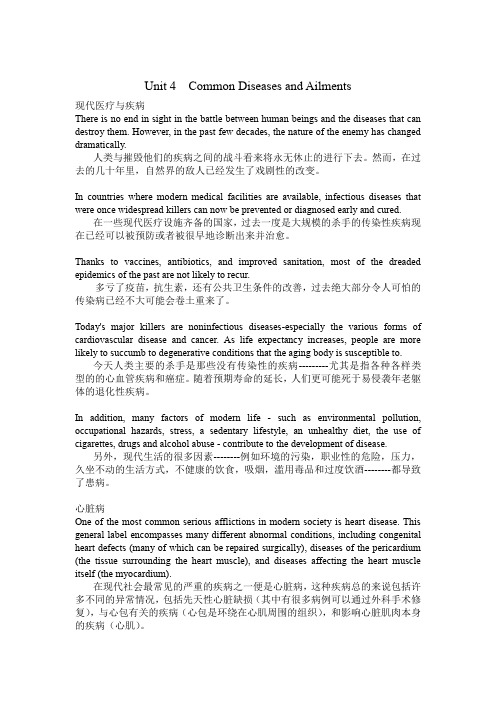
Unit 4 Common Diseases and Ailments现代医疗与疾病There is no end in sight in the battle between human beings and the diseases that can destroy them. However, in the past few decades, the nature of the enemy has changed dramatically.人类与摧毁他们的疾病之间的战斗看来将永无休止的进行下去。
然而,在过去的几十年里,自然界的敌人已经发生了戏剧性的改变。
In countries where modern medical facilities are available, infectious diseases that were once widespread killers can now be prevented or diagnosed early and cured.在一些现代医疗设施齐备的国家,过去一度是大规模的杀手的传染性疾病现在已经可以被预防或者被很早地诊断出来并治愈。
Thanks to vaccines, antibiotics, and improved sanitation, most of the dreaded epidemics of the past are not likely to recur.多亏了疫苗,抗生素,还有公共卫生条件的改善,过去绝大部分令人可怕的传染病已经不大可能会卷土重来了。
Today's major killers are noninfectious diseases-especially the various forms of cardiovascular disease and cancer. As life expectancy increases, people are more likely to succumb to degenerative conditions that the aging body is susceptible to.今天人类主要的杀手是那些没有传染性的疾病---------尤其是指各种各样类型的的心血管疾病和癌症。
医学英语(完整版本)
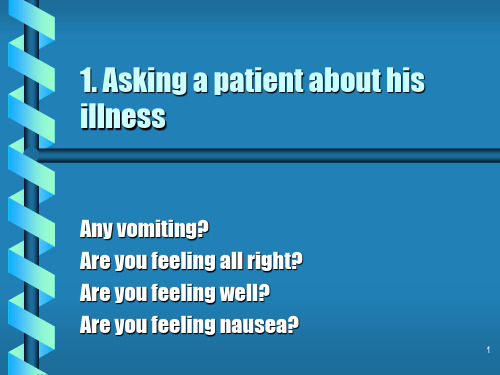
How about your appetite? How bad is it? How far pregnant are you? How long has it been this way? How long has this been going on? How long have you been ill? How long have you been like this? How long have you had it? How long have you had this trouble?
13
I’m aching all over. I’m afraid I’ve got a temperature. I’m feeling rather out of sorts these days. I’m having some trouble sleeping. I’m suffering from insomnia. I’m rather sick. I’m running a fever. I’m running a temperature. I’m under the weather.
11
I feel like vomiting. I feel sick. I feel poorly. I feel rather unwell. I feel very bad. I feel so ill. I feel shivery and I’ve got a sore throat. I feel a dull pain in the stomach. I just feel all pooped out. I keep feeling dizzy.
9
2. Telling a doctor how you feel
医学英语教程生物医学Unit 4课文翻译

Unit 4 Common Diseases and Ailments现代医疗与疾病There is no end in sight in the battle between human beings and the diseases that can destroy them. However, in the past few decades, the nature of the enemy has changed dramatically.人类与摧毁他们的疾病之间的战斗看来将永无休止的进行下去。
然而,在过去的几十年里,自然界的敌人已经发生了戏剧性的改变。
In countries where modern medical facilities are available, infectious diseases that were once widespread killers can now be prevented or diagnosed early and cured.在一些现代医疗设施齐备的国家,过去一度是大规模的杀手的传染性疾病现在已经可以被预防或者被很早地诊断出来并治愈。
Thanks to vaccines, antibiotics, and improved sanitation, most of the dreaded epidemics of the past are not likely to recur.多亏了疫苗,抗生素,还有公共卫生条件的改善,过去绝大部分令人可怕的传染病已经不大可能会卷土重来了。
Today's major killers are noninfectious diseases-especially the various forms of cardiovascular disease and cancer. As life expectancy increases, people are more likely to succumb to degenerative conditions that the aging body is susceptible to.今天人类主要的杀手是那些没有传染性的疾病---------尤其是指各种各样类型的的心血管疾病和癌症。
医学英语课文翻译unit1-7.
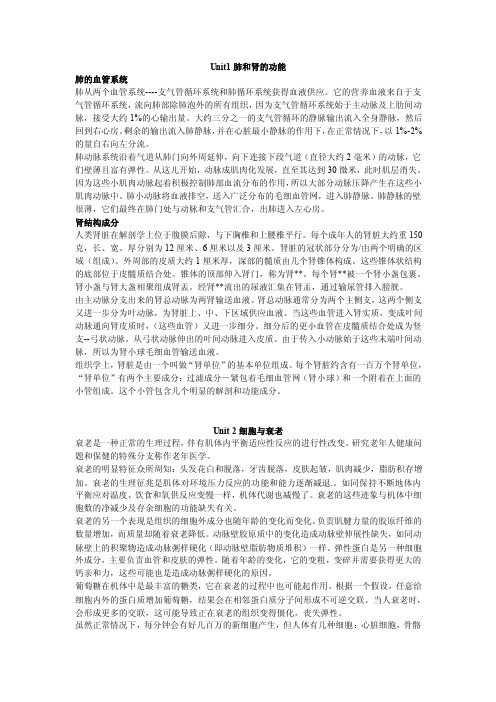
Unit1肺和肾的功能肺的血管系统肺从两个血管系统----支气管循环系统和肺循环系统获得血液供应。
它的营养血液来自于支气管循环系统,流向肺部除肺泡外的所有组织,因为支气管循环系统始于主动脉及上肋间动脉,接受大约1%的心输出量。
大约三分之一的支气管循环的静脉输出流入全身静脉,然后回到右心房。
剩余的输出流入肺静脉,并在心脏最小静脉的作用下,在正常情况下,以1%-2%的量自右向左分流。
肺动脉系统沿着气道从肺门向外周延伸,向下连接下段气道(直径大约2毫米)的动脉,它们壁薄且富有弹性。
从这儿开始,动脉成肌肉化发展,直至其达到30微米,此时肌层消失。
因为这些小肌肉动脉起着积极控制肺部血流分布的作用,所以大部分动脉压降产生在这些小肌肉动脉中。
肺小动脉将血液排空,送入广泛分布的毛细血管网,进入肺静脉。
肺静脉的壁很薄,它们最终在肺门处与动脉和支气管汇合,出肺进入左心房。
肾结构成分人类肾脏在解剖学上位于腹膜后隙,与下胸椎和上腰椎平行。
每个成年人的肾脏大约重150克,长、宽、厚分别为12厘米、6厘米以及3厘米。
肾脏的冠状部分分为/由两个明确的区域(组成)。
外周部的皮质大约1厘米厚,深部的髓质由几个肾锥体构成。
这些锥体状结构的底部位于皮髓质结合处。
锥体的顶部伸入肾门,称为肾**。
每个肾**被一个肾小盏包裹。
肾小盏与肾大盏相聚组成肾盂。
经肾**流出的尿液汇集在肾盂,通过输尿管排入膀胱。
由主动脉分支出来的肾总动脉为两肾输送血液。
肾总动脉通常分为两个主侧支,这两个侧支又进一步分为叶动脉,为肾脏上、中、下区域供应血液。
当这些血管进入肾实质,变成叶间动脉通向肾皮质时,(这些血管)又进一步细分。
细分后的更小血管在皮髓质结合处成为竖支--弓状动脉。
从弓状动脉伸出的叶间动脉进入皮质。
由于传入小动脉始于这些末端叶间动脉,所以为肾小球毛细血管输送血液。
组织学上,肾脏是由一个叫做“肾单位”的基本单位组成。
每个肾脏约含有一百万个肾单位,“肾单位”有两个主要成分:过滤成分―紧包着毛细血管网(肾小球)和一个附着在上面的小管组成。
医学英语 英译汉
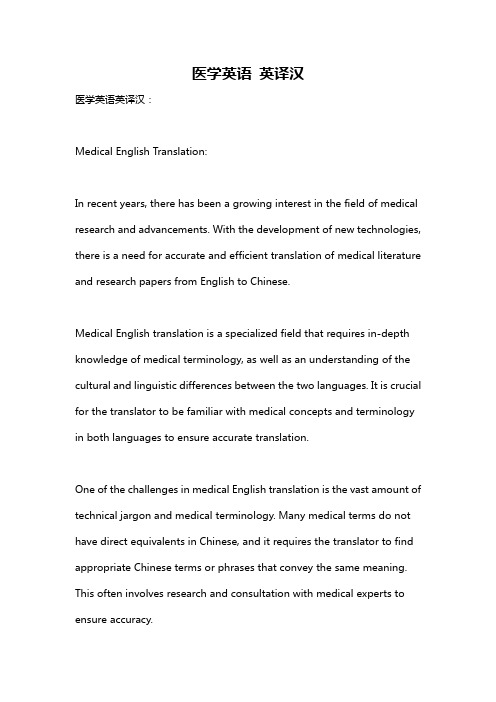
医学英语英译汉医学英语英译汉:Medical English Translation:In recent years, there has been a growing interest in the field of medical research and advancements. With the development of new technologies, there is a need for accurate and efficient translation of medical literature and research papers from English to Chinese.Medical English translation is a specialized field that requires in-depth knowledge of medical terminology, as well as an understanding of the cultural and linguistic differences between the two languages. It is crucial for the translator to be familiar with medical concepts and terminology in both languages to ensure accurate translation.One of the challenges in medical English translation is the vast amount of technical jargon and medical terminology. Many medical terms do not have direct equivalents in Chinese, and it requires the translator to find appropriate Chinese terms or phrases that convey the same meaning. This often involves research and consultation with medical experts to ensure accuracy.Another challenge in medical English translation is the need for cultural sensitivity. Medical literature often includes references to cultural practices and beliefs that may not be familiar to the target audience. The translator must carefully consider how to convey these cultural nuances in a way that is appropriate for the Chinese audience.Medical research papers often require a high level of accuracy and precision in translation. The translator must pay close attention to detail and ensure that the meaning of the original text is preserved. This requires not only linguistic skills but also a deep understanding of the subject matter.In conclusion, medical English translation is a complex and specialized field that requires a thorough understanding of medical terminology, cultural sensitivity, and linguistic skills. It is crucial for the translator to be familiar with medical concepts and terminology in both languages to ensure accurate and efficient translation.使用中文回答:近年来,医学研究和进展领域引起了越来越多的关注。
2019年医学学术英语课文翻译-精选word文档 (4页)
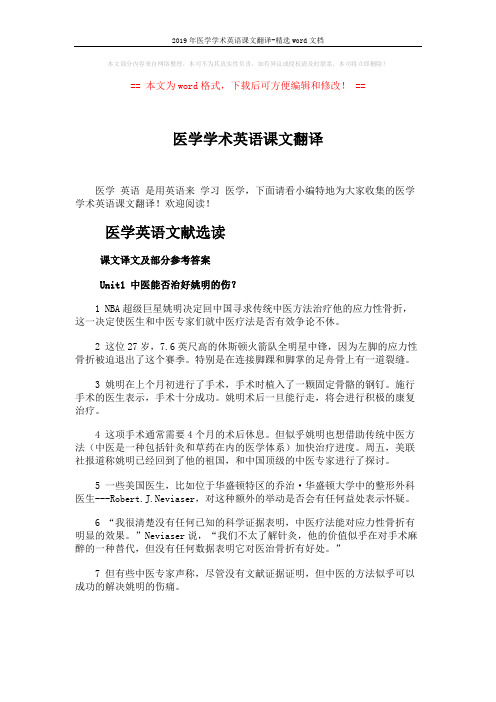
本文部分内容来自网络整理,本司不为其真实性负责,如有异议或侵权请及时联系,本司将立即删除!== 本文为word格式,下载后可方便编辑和修改! ==医学学术英语课文翻译医学英语是用英语来学习医学,下面请看小编特地为大家收集的医学学术英语课文翻译!欢迎阅读!医学英语文献选读课文译文及部分参考答案Unit1 中医能否治好姚明的伤?1 NBA超级巨星姚明决定回中国寻求传统中医方法治疗他的应力性骨折,这一决定使医生和中医专家们就中医疗法是否有效争论不休。
2 这位27岁,7.6英尺高的休斯顿火箭队全明星中锋,因为左脚的应力性骨折被迫退出了这个赛季。
特别是在连接脚踝和脚掌的足舟骨上有一道裂缝。
3 姚明在上个月初进行了手术,手术时植入了一颗固定骨骼的钢钉。
施行手术的医生表示,手术十分成功。
姚明术后一旦能行走,将会进行积极的康复治疗。
4 这项手术通常需要4个月的术后休息。
但似乎姚明也想借助传统中医方法(中医是一种包括针灸和草药在内的医学体系)加快治疗进度。
周五,美联社报道称姚明已经回到了他的祖国,和中国顶级的中医专家进行了探讨。
5 一些美国医生,比如位于华盛顿特区的乔治·华盛顿大学中的整形外科医生---Robert.J.Neviaser,对这种额外的举动是否会有任何益处表示怀疑。
6 “我很清楚没有任何已知的科学证据表明,中医疗法能对应力性骨折有明显的效果。
”Neviaser说,“我们不太了解针灸,他的价值似乎在对手术麻醉的一种替代,但没有任何数据表明它对医治骨折有好处。
”7 但有些中医专家声称,尽管没有文献证据证明,但中医的方法似乎可以成功的解决姚明的伤痛。
8 “这么做毫无问题,如果我是姚明我也会这样做的。
因为传统西方医学中,除了被动地恢复也没有什么好的办法来治疗应力性骨折。
”Raymond Chang博士说,他是位于纽约的“中西药研究院”的院长。
9 “尽管只凭经验没有研究,传统中医在这种情况下是有用的,作为我们中国人所受教育的一部分,在几乎所有中国人的眼里,它是常见的,且享有盛誉,姚明选择这种疗法实在正常不过。
《医学英语》翻译(魏凯峰)

Unit 11.人体面朝上为仰卧位A person is supine when lying face upward .2.人体面朝下为俯卧位A person is prone when lying face downward.3.不同姿势影响对人体相对部位的描述The position of the body can affect the description of body parts relative to each other.4.肘在腕的上方The elbow is above the hand.5.方位术语描述人体不同部位之间的相对关系Directional terms describe parts of the body relative to each other.6.头部在人体的最高点The head is the highest point of human body.7.人体的前面是腹面The anterior surface of the human body is the ventral surface.8.脚在腿部的远端The foot is attached at distal end to leg.9.外侧面指远离中线的方向Lateral means away from the midline.10.鼻位于眼睛内侧The nose is located in a medial position in the face.11.皮肤在肌肉和骨的表面The skin is superficial to the muscle and bone.12.矢状面将人体分为左右两部分A sagittal plane separates the body into right and left portions.13.冠状面从左到右垂直穿过人体A coronal plane runs vertically from right to left.14.体腔包括鼻腔、颅腔、腹腔等The body contains the nasal, cranial, and abdominal cavities etc.15.纵膈中有心脏、胸腺、气管、食道以及血管、神经等。
医学英语第三册(MedicalEnglishthirdvolumes)

医学英语第三册(Medical English third volumes)Possess, V. yes, have; masterMagical adj. has magic, magicalAssume v. assumes, assumes, assumesLink, N. contact, connectionOptimist n. optimistsView v. look, think, observeIn a blue mood is in a bad moodProfound, adj., deep, profoundElectromagnetic, adj., electromagneticBeholder n. viewers, witnessesPsychologist n. psychologistElicit, vt., cause to issueStir v. to move or excite; stirPatriotism, N., patriotism, patriotismAffection n. gentle, dearAntidote n. correction method, antidote Raise v. feeding, tendingRainbow n. rainbowSpectrum n. spectraA, spectrum, of, continuous, serial Startling adj. is amazingFlash n. flash, a sudden shotAlga n. algaeMate v. matingInterior, adj., interior, interior Decorator n. house decoration people Illumination n. lighting; lighting fixtures Nearsighted, adj., near sightedBlurry adj. blurred visionWear, v., wear, wearGlasses n. glassesAt arm's length arm can reach near.What is called, so called... TheAstigmatism n. astigmatismCorrect, V. correction, correction, correction Cataract n. cataractFaint adj., obscure, darkCloudy adj. fuzzy; cloudyBe accustomed to is used toRather than (Ning)... Rather than...Camera cameraOpening n. openingAdjust v. regulation; adjust and tidy up Diaphragm n. aperture, light barPupil n. pupilPhotograph, v., take picturesIndistinct adj. is not clearClose by, not far from hereDistance n. distance; distanceSpeck n. spots; stainsRelax vt. relax and relaxNow, and, then sometimes, from time to time Concentrate v. concentrate strength or attention on Complicated, adj., obscure, obscure Unacquainted, with, yeah... Not familiar withAngle n. angleRetain, v., keep, keep; keepMoving picture moviesSuccession, N. continuous, successive, continue Fraction n. part, fragmentScreen, N. screen, screenJumpy, adj., neuroticFashion n. look, the wayTeenager n., 13 to 19 year old young manComment n. comments; explanations; explanations Creative, adj., creativeImaginative, adj., fancyLogic, N., logic reasoning, logicEducated, adj., educatedSyllabus n. syllabus; curriculum scheduleItem n. items, termsBalance VI. & vt. balance and balance state; n. scale Episode n. event; episodeVivid adj.; vivid; brightRevision n. review, review, revisionRevise v. review, review, revisionPhenomenon n. phenomenonTechnology n. technology, technology Meaningful adj. has profound meaning Statistics, N. statistics, statistics Demography n. demographic statistics Census, N. demographics, censusYearbook n. YearbookWork out worked out; the results worked Infanticide n. infanticideStarvation n. starve, starve to death Typical adj. typical and representative Tribal, adj., clan, clanUniversal adj. universal, consistent Explosion n. explosion; explosion, explosion More or less more or less; left and right Transitional, adj., transition, transferred Distinctive adj. has its own featuresProductivity, N. production capacity, productivity Primitive adj. primitive; simpleAgriculture, N., agriculture, agronomyProductive adj. rich; produce... TheSophisticated adj.; sophisticated; sophisticated Applicable ad.; appropriate; applicableFertility, N., fertility, fertilityStabilize, v., stability, stabilityMortality n. death number; mortalityDecline, N., decline, declineAnnual, adj., year, yearBillion n. (UK) trillion; (beauty) one billion Inflation n. inflationTag n. tags, tagsReplace v. put it back in placeCompete, v., competition, competitionCat computed tomography scanScanner n. scannerDialysis n. dialysisInvestment n. investment; investmentCompetition n. competition; competitionLicence v. issued a licenseBoard n. Committee, Council, BureauTrend, N. trends, tendenciesSpecialization n. specialization and specialization Primary care was initially treated with primary treatment General practice general practitioner, family doctor Specialty n. majorInner, adj., internal, includedPediatrics n. PediatricsCardiologist n., a heart specialistCrisis n. turning point; shock; crisisCritic n. critics; a criticEarn v. earned, earnedIncome n. revenueMake, up, for compensation, make upEarnings income, income salaryInsurance n. insurance premiumLegal adj. legalOrthopedics n. orthopedic bone, bone; Science Malpractice n. misconduct; dereliction of duty Regardless of ignores; regardless of disregard Costly, adj., expensive, expensiveGallbladder n. gall bladderGreed, N., greed, greedIncentive, N., stimulation, seductionProfit n. profit; benefitDense adj.; dense; denseFog n. fog, fog, confusionValley, N. valleys, valleys, watersheds Belgium n. BelgiumFoggy adj. foggy; obscureStrain v. straining; striving, striving Chemical, N., chemicals, chemicalsMilky, adj., milk, milkRoll v. scrollFurnace, N., furnace, furnace, blast furnace Inversion, N. reverse, inverted, inverted Lid n. lids; lids; hatsPile, up, heaps, heapsSoot, N. soot, sootAirport n. airport, air terminalA chain of chain n.; chains; collars Collision n. collisionHighway n. highway, main roadLos Angeles Los AngelesSting, v., sting, stingPhotochemical, N., light emitting chemicals Nitrogen n. nitrogenOxide n. oxideRefinery n. refinery; refineryProhibit v. prohibited; blockedChimney n. chimney, chimneySun-powered adj. solar poweredEngine n. engines, enginesSolar, adj., sun, daylightDevice n. design, device, planPower v. powered by powerSatellite n. satellite; man-made satellite Capture, V. capture, capture, capture Chlorophyll, N., chlorophyllStarch n. starch; starchy foodGlycogen n. animal glycogen, starchEyebrow n. eyebrows, eyebrowsOverheat, V. heating too large, over heating Clap v. clap your handsChilly adj. cold; unfriendlyShiver, v., trembling, tremblingBundle n. bundles; packages; parcelsScatter v. scatter; scatter; scatterBiceps n. two muscleThumb n. (big) thumbRegiment n. regiment; a large crowdMessage, N., communications, messages, information Relay v. split delivery; retransmissionInstantly ad. immediately, instantlyInvoluntary adj. is optionalAutonomic, adj., autonomous, spontaneousRout v. (delivered by a certain route)Radar n. radar, radio detectorBombard, v., bombardment, bombing, collision Hourly adj. & ad. per hourRecoil v. back, back to back;Gravity n. gravityJerk v. jerked; muscle contractionFlex v. buckling (limbs)Rectangle n. rectangle, rectangleIris n. iris; rainbowReceptors for receptor, N. receptorsBack, and, forth, come and goFeed v. supply... Give, feed (raise)Sort v. put... classificationFile v. put... FileBud, n. (Jie Pou) bud, bud; budOptic, adj., ocular, visualRadiate v. emission (light or heat), radiation Skyscraper n. skyscraperPuberty n. pubertySomatic adj.; somatic; parietalPrecede v. precedes... Ratio... first Trigger, v., cause, exciteHypothalamic adj. in the hypothalamus Pubescent adj. pubertyThe sudden explosion of spurt n. burst forth遇到诉遭遇,遇到身材,身高,身材值得注意的。
医学英语课文翻译
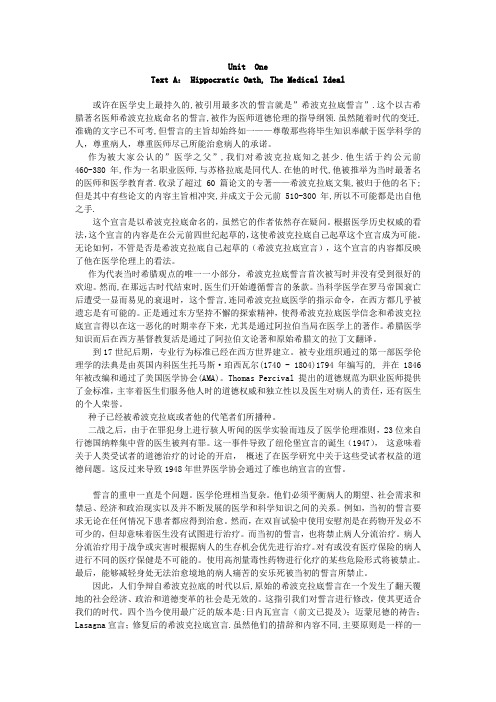
Unit OneText A: Hippocratic Oath, The Medical Ideal或许在医学史上最持久的,被引用最多次的誓言就是”希波克拉底誓言”.这个以古希腊著名医师希波克拉底命名的誓言,被作为医师道德伦理的指导纲领.虽然随着时代的变迁,准确的文字已不可考,但誓言的主旨却始终如一——尊敬那些将毕生知识奉献于医学科学的人,尊重病人,尊重医师尽己所能治愈病人的承诺。
作为被大家公认的”医学之父”,我们对希波克拉底知之甚少.他生活于约公元前460-380年,作为一名职业医师,与苏格拉底是同代人.在他的时代,他被推举为当时最著名的医师和医学教育者.收录了超过60篇论文的专著——希波克拉底文集,被归于他的名下;但是其中有些论文的内容主旨相冲突,并成文于公元前510-300年,所以不可能都是出自他之手.这个宣言是以希波克拉底命名的,虽然它的作者依然存在疑问。
根据医学历史权威的看法,这个宣言的内容是在公元前四世纪起草的,这使希波克拉底自己起草这个宣言成为可能。
无论如何,不管是否是希波克拉底自己起草的(希波克拉底宣言),这个宣言的内容都反映了他在医学伦理上的看法。
作为代表当时希腊观点的唯一一小部分,希波克拉底誓言首次被写时并没有受到很好的欢迎。
然而,在那远古时代结束时,医生们开始遵循誓言的条款。
当科学医学在罗马帝国衰亡后遭受一显而易见的衰退时,这个誓言,连同希波克拉底医学的指示命令,在西方都几乎被遗忘是有可能的。
正是通过东方坚持不懈的探索精神,使得希波克拉底医学信念和希波克拉底宣言得以在这一恶化的时期幸存下来,尤其是通过阿拉伯当局在医学上的著作。
希腊医学知识而后在西方基督教复活是通过了阿拉伯文论著和原始希腊文的拉丁文翻译。
到17世纪后期,专业行为标准已经在西方世界建立。
被专业组织通过的第一部医学伦理学的法典是由英国内科医生托马斯·珀西瓦尔(1740 - 1804)1794年编写的, 并在1846年被改编和通过了美国医学协会(AMA)。
医学英语教程课文翻译Unit1
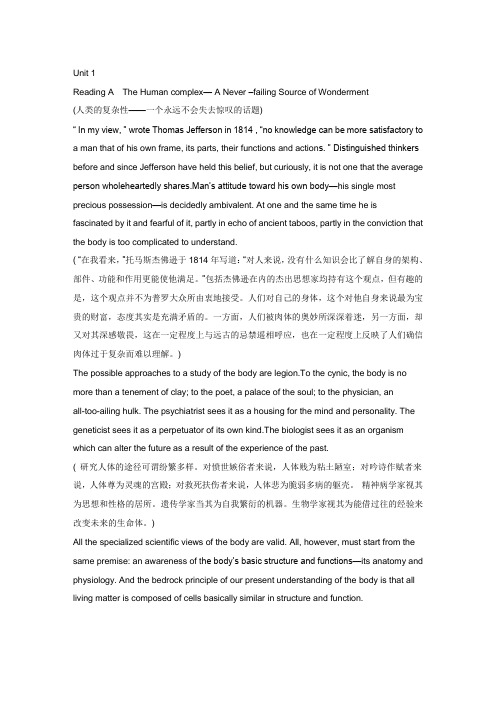
Unit 1Reading A The Human complex— A Never –failing Source of Wonderment(人类的复杂性——一个永远不会失去惊叹的话题)“ In my view, ” wrote Thomas Jefferson in 1814 , “no knowledge can be more satisfactory to a man that of his own frame, its parts, their functions and action s. ” Distinguished thinkers before and since Jefferson have held this belief, but curiously, it is not one that the average person wholeheartedly shares.Man’s attitude toward his own body—his single most precious possession—is decidedly ambivalent. At one and the same time he is fascinated by it and fearful of it, partly in echo of ancient taboos, partly in the conviction that the body is too complicated to understand.( “在我看来,”托马斯杰佛逊于1814年写道:“对人来说,没有什么知识会比了解自身的架构、部件、功能和作用更能使他满足。
”包括杰佛逊在内的杰出思想家均持有这个观点,但有趣的是,这个观点并不为普罗大众所由衷地接受。
人们对自己的身体,这个对他自身来说最为宝贵的财富,态度其实是充满矛盾的。
医学英语综合教程第三版课文第五章翻译

医学英语综合教程第三版课文第五章翻译中医,是我国劳动人民创造的传统医学。
我国有许多历代中医名家,如扁鹊、华佗、李时珍。
而今天,我们小记者要去中医院一睹中医的风采。
来到中医院,我们径直来到了6楼,由治未病的李艳医师给我们上课,我了解了中医四大经典《黄帝内经》、《难经》、《伤寒杂病论》、《神农草经》,大家在课后可以去看看哦!我还了解了原来中药是指在中医的指导下预防、诊断、治疗人体机能的药物。
竟然还有植物类、动物类、介壳和矿物类呢!中医不像西医,中医有很多无毒副作用的外治疗法,如针灸、艾炙、火罐、刮痧、推拿等,可以治疗很多痛症及内科,外科疾病。
听完课,我们又来到了“中医综合治疗室”,一进门:天哪,中医竟然是这么治疗的,实在是太可怕了!我赶紧跑了一个医师后面,他正在和中风的病人扎针灸,只见病人的头上、肩上都插满了银针。
见有根银针没插好,医生活生生地拔了出来,又插了进去,可病人却毫无表情,似乎什么事也没发生过。
再看另一位病人,他的肩膀、颈椎上插满了像烟似的艾炙,上面冒着白雾,还散发着腾腾的热气。
随后,医生拿了几个充满电流的夹子夹在了银针上,病人的身体不由自主地颤动起来,我立马担心起来:“叔叔,请问针灸和艾炙插在身上痛吗?艾炙有什么功效吗?”“只有轻微的疼痛,跟西医的扎针差不多,艾炙呢,可以治疗肩膀疼,颈椎痛,还可以矫正胎位呢!”每个医院都有药房,中医院当然也有药房啦!来到“放心药房”,一阵浓浓的中草药味扑鼻而来,两个阿姨正在给病人家属配药,小记者们品尝各种各样的中药,药房里其乐融融。
随后,我们去了骨科,知道中医骨伤科相比西医:“不开刀,不吃药,花费少,康复快。
”最后,我们还向李艳医师提了各种不懂的问题……中医,是我们中国的医学,中医花费少,还康复的快,建议大家可以用中医治病哦!。
《医学英语》翻译(魏凯峰)
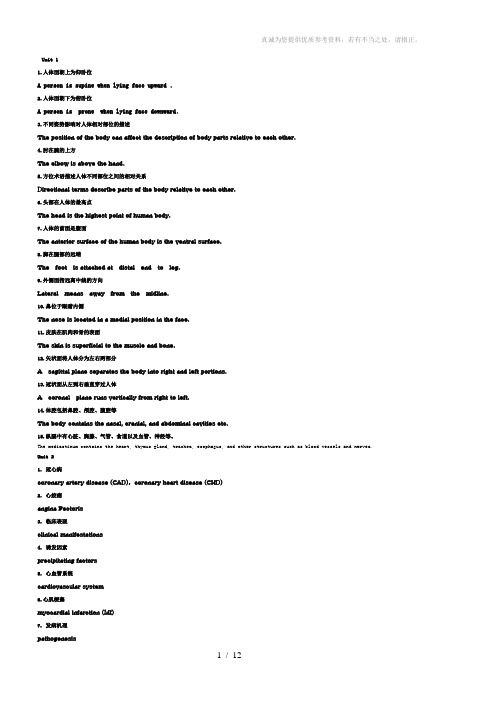
Unit 11.人体面朝上为仰卧位A person is supine when lying face upward .2.人体面朝下为俯卧位A person is prone when lying face downward.3.不同姿势影响对人体相对部位的描述The position of the body can affect the description of body parts relative to each other.4.肘在腕的上方The elbow is above the hand.5.方位术语描述人体不同部位之间的相对关系Directional terms describe parts of the body relative to each other.6.头部在人体的最高点The head is the highest point of human body.7.人体的前面是腹面The anterior surface of the human body is the ventral surface.8.脚在腿部的远端The foot is attached at distal end to leg.9.外侧面指远离中线的方向Lateral means away from the midline.10.鼻位于眼睛内侧The nose is located in a medial position in the face.11.皮肤在肌肉和骨的表面The skin is superficial to the muscle and bone.12.矢状面将人体分为左右两部分A sagittal plane separates the body into right and left portions.13.冠状面从左到右垂直穿过人体A coronal plane runs vertically from right to left.14.体腔包括鼻腔、颅腔、腹腔等The body contains the nasal, cranial, and abdominal cavities etc.15.纵膈中有心脏、胸腺、气管、食道以及血管、神经等。
医学英语课文翻译
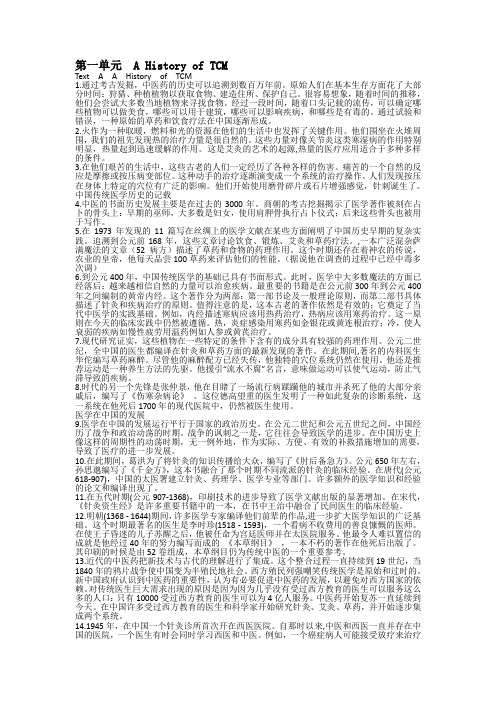
第一单元 A History of TCMText A A History of TCM1.通过考古发掘,中医药的历史可以追溯到数百万年前。
原始人们在基本生存方面花了大部分时间:狩猎、种植植物以获取食物、建造住所、保护自己。
很容易想象,随着时间的推移,他们会尝试大多数当地植物来寻找食物。
经过一段时间,随着口头记载的流传,可以确定哪些植物可以做美食,哪些可以用于建筑,哪些可以影响疾病,和哪些是有毒的。
通过试验和错误,一种原始的草药和饮食疗法在中国逐渐形成。
2.火作为一种取暖,燃料和光的资源在他们的生活中也发挥了关键作用。
他们围坐在火堆周围,我们的祖先发现热的治疗力量是很自然的。
这些力量对像关节炎这类寒湿病的作用特别明显,热量起到迅速缓解的作用。
这是艾灸的艺术的起源,热量的医疗应用适合于多种多样的条件。
3.在他们艰苦的生活中,这些古老的人们一定经历了各种各样的伤害。
痛苦的一个自然的反应是摩擦或按压病变部位。
这种动手的治疗逐渐演变成一个系统的治疗操作。
人们发现按压在身体上特定的穴位有广泛的影响。
他们开始使用磨骨碎片或石片增强感觉,针刺诞生了。
中国传统医学历史的记载4.中医的书面历史发展主要是在过去的3000年。
商朝的考古挖掘揭示了医学著作被刻在占卜的骨头上:早期的巫师,大多数是妇女,使用肩胛骨执行占卜仪式;后来这些骨头也被用于写作。
5.在1973年发现的11篇写在丝绸上的医学文献在某些方面阐明了中国历史早期的复杂实践。
追溯到公元前168年,这些文章讨论饮食、锻炼、艾灸和草药疗法。
,一本广泛混杂萨满魔法的文章(52病方)描述了草药和食物的药理作用。
这个时期还存在着神农的传说,农业的皇帝,他每天品尝100草药来评估他们的性能。
(据说他在调查的过程中已经中毒多次调)6.到公元400年,中国传统医学的基础已具有书面形式。
此时,医学中大多数魔法的方面已经落后;越来越相信自然的力量可以治愈疾病。
最重要的书籍是在公元前300年到公元400年之间编制的黄帝内经。
医学英语重点3——翻译

医学英语重点翻译11.英译中3分——范围:西曼博士的《中美针灸》,实验设计方法(附件1)A Zelen-design randomized clinical trial was conducted. The trial protocol adhered to STRICTA guidelines (see trial protocol in Supplement 1). The institutional human ethics committee approved the study. Participants provided written informed consent. We recruited participants from metropolitan Melbourne and regional Victoria (Australia) via advertisements in the community, media, andmedical/physical therapy clinics between February 2010 and December 2011. People were included if they were aged 50 years or older, had knee pain of longer than 3 months’ duration, had knee pain most days with average severity of 4 or more out of 10 on a numeric rating scale (NRS), and had morning stiffness lasting less than 30 minutes. These criteria are consistent with clinical guidelines advocating a clinical diagnosis of osteoarthritis without need for investigations if these criteria are fulfilled. Exclusion criteria are provided in eTable 1 in Supplement 2. For bilaterally eligible knees, only the most symptomatic knee was evaluated (although acupuncturists were permitted to treat both knees).我们进行了一个Zelen设计的随机临床试验。
医学英语教程生物医学课文翻译
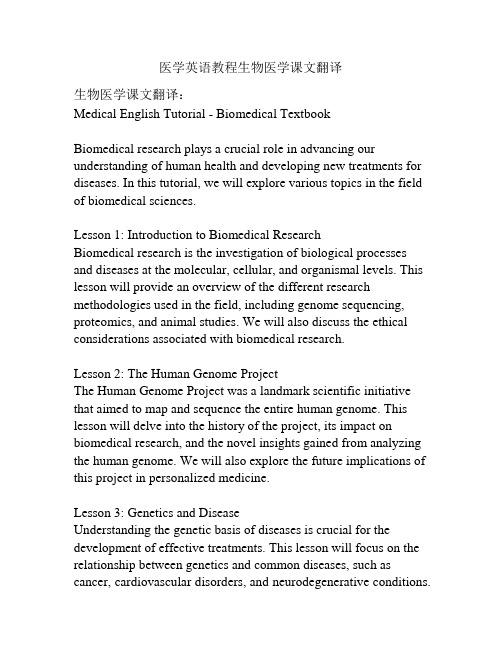
医学英语教程生物医学课文翻译生物医学课文翻译:Medical English Tutorial - Biomedical TextbookBiomedical research plays a crucial role in advancing our understanding of human health and developing new treatments for diseases. In this tutorial, we will explore various topics in the field of biomedical sciences.Lesson 1: Introduction to Biomedical ResearchBiomedical research is the investigation of biological processes and diseases at the molecular, cellular, and organismal levels. This lesson will provide an overview of the different research methodologies used in the field, including genome sequencing, proteomics, and animal studies. We will also discuss the ethical considerations associated with biomedical research.Lesson 2: The Human Genome ProjectThe Human Genome Project was a landmark scientific initiative that aimed to map and sequence the entire human genome. This lesson will delve into the history of the project, its impact on biomedical research, and the novel insights gained from analyzing the human genome. We will also explore the future implications of this project in personalized medicine.Lesson 3: Genetics and DiseaseUnderstanding the genetic basis of diseases is crucial for the development of effective treatments. This lesson will focus on the relationship between genetics and common diseases, such as cancer, cardiovascular disorders, and neurodegenerative conditions.We will also discuss the advancements in genetic testing and the potential of gene therapy.Lesson 4: Stem Cells and Regenerative MedicineStem cells have the unique ability to differentiate into various cell types, making them valuable tools in regenerative medicine. This lesson will explore the different types of stem cells, their therapeutic potential, and the current challenges in their clinical application. We will also discuss recent breakthroughs in tissue engineering and organ transplantation.Lesson 5: Drug Discovery and DevelopmentDeveloping new drugs is a complex and rigorous process. In this lesson, we will explore the steps involved in drug discovery, from target identification to preclinical and clinical trials. We will also discuss the role of animal models in drug testing and the importance of drug safety and efficacy.Lesson 6: Biomedical ImagingImaging techniques play a vital role in diagnosing diseases and monitoring treatment efficacy. This lesson will provide an overview of various imaging modalities used in biomedical research, such as X-ray, MRI, and PET. We will also discuss the advancements in imaging technology and their application in precision medicine.Lesson 7: Biomedical EthicsEthical considerations are essential in biomedical research to ensure the welfare of human and animal subjects. This lesson will discuss the ethical principles and guidelines governing biomedicalresearch. We will also explore the ethical dilemmas associated with emerging technologies, such as gene editing and artificial intelligence in healthcare.By the end of this tutorial, you will have a comprehensive understanding of key concepts and advancements in the field of biomedical sciences. This knowledge will enable you to actively engage in discussions and contribute to the ever-evolving field of medical research.。
医学英语新教程(下册)课文翻译

医学英语(下册)课文翻译UNIT 1 疾病的介绍1 人体是一个艺术的杰作。
我们对身体的功能了解越深,就越赏识。
即使在生病时,身体在故障修复和补偿方面表现也相当出色。
身体内不断发生变化,然而,一个叫内环境稳定(稳态)的平稳状态能大抵保持平衡。
机体内环境稳定出现某种重大的紊乱,就能引起各种各样的反应,这些反应常常促使疾病的体征和症状出现。
比如,由于运动员对氧气的需求增加,他们体内的红细胞计数就会异常升高。
这是一个使更多血红蛋白循环的自然补偿机制,但它却是红细胞增多症的一个症状。
2 当一个器官需要做更多工作时,它往往会增大,肥大。
心脏会因为长期的高血压而增大,因为它必须不间断地克服巨大的阻力把血液输送到全身。
当瓣膜存在缺陷时,心肌同样也会肥大,因为那些要么太宽,要么太窄的瓣膜需要额外的抽吸作用。
如果一个肾衰竭了,另一个肾就会增大以满足身体的需要,并弥补那个有缺陷的肾。
当流向这两个肾的血液不足时,它们会通过分泌荷尔蒙(激素)的方式帮助血压升高。
然而,如果某个器官或身体的某个部位没有得到使用,它就会萎缩,或者,也就是说,面积变小或功能下降。
3 血液在维持内环境稳定方面发挥着几个作用。
当组织受到创伤,损伤,或者感染时,血流就会积聚在受损区域。
这是极其重要的,因为血液携带了专门用于清除有害物质和细胞碎片的细胞。
血液中的其他细胞则产生抗体,以抵抗致病生物的入侵。
4 疾病是某个身体部位,生理系统,或整个身体的不健康状态,其中结构或功能发生紊乱。
疾病经常始于细胞水平。
一个异常的基因不管是因遗传所得,还是因环境因素引起突变或变异,都能启动疾病程序。
比如,当基因信息遭到侵袭(常被病毒侵袭),癌症的发生会伴随着细胞的疯长。
新的研究方法使某些疾病能与异常基因的发现联系起来。
疾病可以是一种结构性的异常,比如,先天性心脏缺陷,也可以是没有器质性改变的功能性病变。
疾病可能是一种结构性的异常,比如,先天性心脏缺陷,也可能是没有器质性变化的功能性病变,比如,高血压或外伤。
医药英语教程第四单元课文翻译
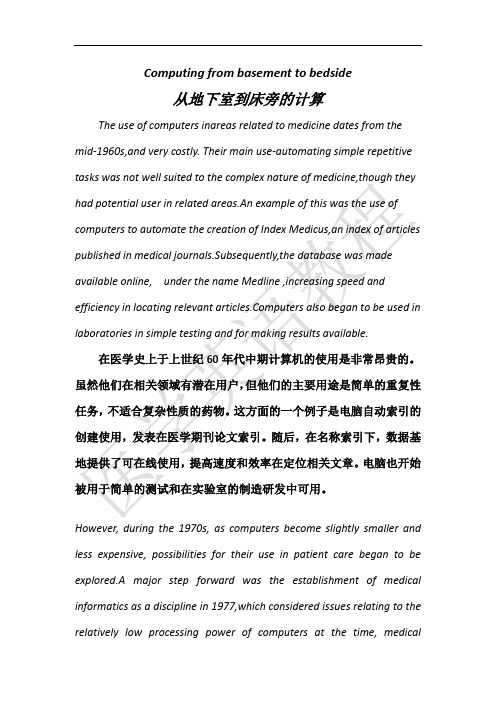
Computing from basement to bedside从地下室到床旁的计算The use of computers inareas related to medicine dates from the mid-1960s,and very costly. Their main use-automating simple repetitive tasks was not well suited to the complex nature of medicine,though they had potential user in related areas.An example of this was the use of computers to automate the creation of Index Medicus,an index of articles published in medical journals.Subsequently,the database was made available online, under the name Medline ,increasing speed and efficiency in locating relevant puters also began to be used in laboratories in simple testing and for making results available.在医学史上于上世纪60年代中期计算机的使用是非常昂贵的。
虽然他们在相关领域有潜在用户,但他们的主要用途是简单的重复性任务,不适合复杂性质的药物。
这方面的一个例子是电脑自动索引的创建使用,发表在医学期刊论文索引。
随后,在名称索引下,数据基地提供了可在线使用,提高速度和效率在定位相关文章。
电脑也开始被用于简单的测试和在实验室的制造研发中可用。
21世纪大学公共医学英语上册课文翻译
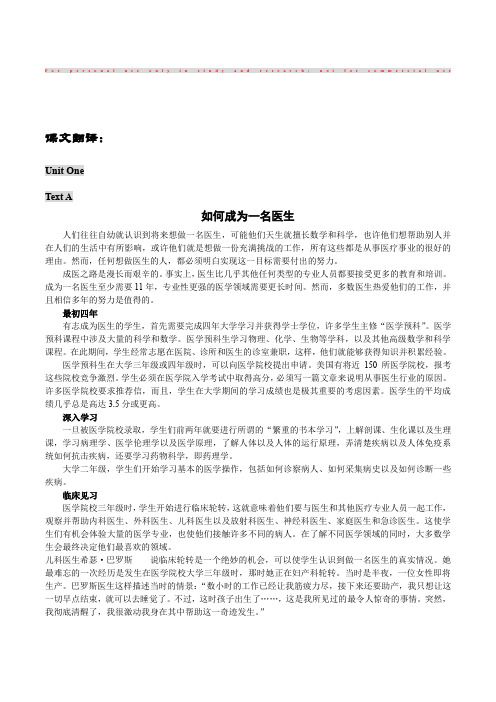
F o r p e r s o n a l u s e o n l y i n s t u d y a n d r e s e a r c h;n o t f o r c o m m e r c i a l u s e课文翻译:Unit OneText A如何成为一名医生人们往往自幼就认识到将来想做一名医生,可能他们天生就擅长数学和科学,也许他们想帮助别人并在人们的生活中有所影响,或许他们就是想做一份充满挑战的工作,所有这些都是从事医疗事业的很好的理由。
然而,任何想做医生的人,都必须明白实现这一目标需要付出的努力。
成医之路是漫长而艰辛的。
事实上,医生比几乎其他任何类型的专业人员都要接受更多的教育和培训。
成为一名医生至少需要11年,专业性更强的医学领域需要更长时间。
然而,多数医生热爱他们的工作,并且相信多年的努力是值得的。
最初四年有志成为医生的学生,首先需要完成四年大学学习并获得学士学位,许多学生主修“医学预科”。
医学预科课程中涉及大量的科学和数学。
医学预科生学习物理、化学、生物等学科,以及其他高级数学和科学课程。
在此期间,学生经常志愿在医院、诊所和医生的诊室兼职,这样,他们就能够获得知识并积累经验。
医学预科生在大学三年级或四年级时,可以向医学院校提出申请。
美国有将近150所医学院校,报考这些院校竞争激烈。
学生必须在医学院入学考试中取得高分,必须写一篇文章来说明从事医生行业的原因。
许多医学院校要求推荐信,而且,学生在大学期间的学习成绩也是极其重要的考虑因素。
医学生的平均成绩几乎总是高达3.5分或更高。
深入学习一旦被医学院校录取,学生们前两年就要进行所谓的“繁重的书本学习”,上解剖课、生化课以及生理课,学习病理学、医学伦理学以及医学原理,了解人体以及人体的运行原理,弄清楚疾病以及人体免疫系统如何抗击疾病,还要学习药物科学,即药理学。
大学二年级,学生们开始学习基本的医学操作,包括如何诊察病人、如何采集病史以及如何诊断一些疾病。
- 1、下载文档前请自行甄别文档内容的完整性,平台不提供额外的编辑、内容补充、找答案等附加服务。
- 2、"仅部分预览"的文档,不可在线预览部分如存在完整性等问题,可反馈申请退款(可完整预览的文档不适用该条件!)。
- 3、如文档侵犯您的权益,请联系客服反馈,我们会尽快为您处理(人工客服工作时间:9:00-18:30)。
Unit 11.人体面朝上为仰卧位A person is supine when lying face upward .2.人体面朝下为俯卧位A person is prone when lying face downward.3.不同姿势影响对人体相对部位的描述The position of the body can affect the description of body parts relative to each other.4.肘在腕的上方The elbow is above the hand.5.方位术语描述人体不同部位之间的相对关系Directional terms describe parts of the body relative to each other.6.头部在人体的最高点The head is the highest point of human body.7.人体的前面是腹面The anterior surface of the human body is the ventral surface.8.脚在腿部的远端The foot is attached at distal end to leg.9.外侧面指远离中线的方向Lateral means away from the midline.10.鼻位于眼睛内侧The nose is located in a medial position in the face.11.皮肤在肌肉和骨的表面The skin is superficial to the muscle and bone.12.矢状面将人体分为左右两部分A sagittal plane separates the body into right and left portions.13.冠状面从左到右垂直穿过人体A coronal plane runs vertically from right to left.14.体腔包括鼻腔、颅腔、腹腔等The body contains the nasal, cranial, and abdominal cavities etc.15.纵膈中有心脏、胸腺、气管、食道以及血管、神经等。
The mediastinum contains the heart, thymus gland, trachea, esophagus, and other structures such as blood vessels and nerves. Unit 21. 冠心病coronary artery disease (CAD),coronary heart disease (CHD)2. 心绞痛angina Pectoris3. 临床表现clinical manifestations4. 诱发因素precipitating factors5. 心血管系统cardiovascular system6.心肌梗塞myocardial infarction (MI)7. 发病机理pathogenesis8. 血管痉挛vasospasm9.交叉性栓子paradoxical emboli10. 缺血性心肌病ischemic cardiomyopathy11. 如果心脏没有足够的含氧血液供给, 就可能发生胸痛即心绞痛When the heart has not enough oxygenated blood supply, chest pain will be resulted, called angina.12.心绞痛是冠心病的一个常见症状Angina is a common symptom for coronary heart disease.13.一般体力活动(如步行和登楼)不受限, 仅在强、快、或长时间劳力时发生心绞痛Ordinary physical activity, such as walking and climbing stairs, does not cause angina. Angina with strenuous1or rapid or prolonged exertion at work or recreation.14.一切体力活动都引起不适, 静息时发生心绞痛Inability to carry on any physical activity , angina syndrome may be present at rest.15.在缺血性心脏病引起的死亡中, 缺血性心肌病多达40%Ischmic cardiomyopathy is responsible for as much as 40% of the mortality in ischemic heart disease (IHD)Unit 31.肺泡alveolous2.低氧血症hypoxemia3.终末细支气管the terminal bronchioles4.急性呼吸道感染acute respiratory tract infections5.二氧化碳潴留carbon dioxide trapping6.动脉血气分析Arterial blood gas analysis7.慢性呼吸衰竭chronic respiratory failure8.肺气肿没有明显的肺纤维化。
Emphysema without obvious fibrosis9.慢性阻塞性肺病包括两个相关的疾病:慢性支气管炎和肺气肿。
COPD actually comprises two related diseases, chronic bronchitis and emphysema.10.引起慢性支气管炎的各种因素如感染、吸烟、大气污染、职业性粉尘和有害的气体的长期吸入、过敏等, 均可引起慢性阻塞性肺病, 其中主要因素是吸烟。
Chronic bronchitis is caused by all kinds of factors, such as infection, cigarette smoking, air pollution, inhalations and allergies of powder and toxic fumes from work in a long history, which occurred COPD, and cigarette smoking is the most important one . 11.治疗慢性阻塞性肺病的主要目的在于改善呼吸功能, 提高患者工作和生活的能力。
The main purpose of therapy for COPD is improve respiration function and elevate the work and living ability of patients.12.慢性阻塞性肺病多发于长期吸烟的人群。
COPD typically occurs insidiously in individuals with a long history of cigarette smoking.13.健康教育对于慢阻肺患者很重要。
Health education can play an important role to COPD.14.停止吸烟有助于疾病的所有过程。
Stopping smoking is beneficial at all stages of the disease. Nicotine.15.长期氧疗可以提高存活期。
Long term oxygen therapy may increase life expectancy of patientsUnit 41. 软化食物soften the food2. 内痔internal hemorrhoids3. 肛周脓肿perianal abscesses4. 部分消化的食物partially digested food5. 结肠息肉colon polyps6. 感染性结肠炎infectious colitis7. 排便习惯改变a change in normal bowel habits8. 肠易激惹综合征irritable bowel syndrome9.利用多种筛查, 可以在出现症状之前防治结肠癌By using a variety of screening tests, it is possible to prevent, detect, and treat the disease long before symptoms appear. 10.几乎所有的结肠直肠癌起源于息肉Almost all colorectal cancers begin as polyps.11.便秘通常由食物中缺乏纤维所致Constipation is usually caused by inadequate fiber in the diet.12.结肠结构异常需进行外科治疗The structural abnormality of colon needs to be treated surgically.13.肛裂的治疗包括服用止痛药、多食食物纤维及药物坐浴Treatment for anal fissures includes pain medicine, more dietary fiber and sitz baths with drugs.14.胰腺可以分泌唾液淀粉酶Pancreas can secrete ptyalin.15.通过保持建康的生活方式, 许多结肠和直肠疾病可以得到预防Many diseases of the colon and rectum can be prevented by maintaining a healthy lifestyle.Unit 51. 如果肾小球损害严重, 红细胞穿过肾小球, 形成血尿。
If the glomeruli are severely damaged, erythrocytes pass through causing haematuria.2. 毒素在体内堆积。
Toxins build up in the body.3. 只有一个肾脏可以即可以正常发挥作用。
Kidneys can carry out their normal functions even if only one is working.4. 最常见的肾衰的原因是糖尿病和高血压。
